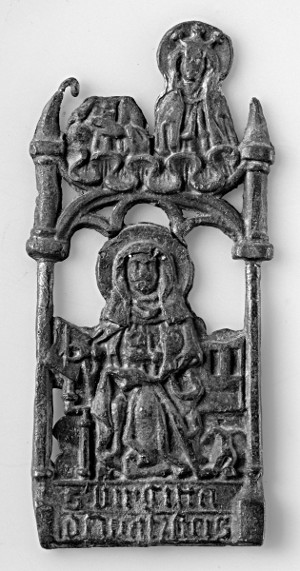 14th century pilgrim's badge of St. Bridget found in the River Fyris at Uppsala.
14th century pilgrim's badge of St. Bridget found in the River Fyris at Uppsala.
Fornvännen 2015:3 is now on-line on Open Access.
- Lars Larsson on an unusual Late Neolithic burial monument at the record-breaking 1st millennium site of Uppåkra.
- Christina Fredengren on deposition of human and animal bodies in the waters of inland Uppland.
- Lars Liedgren and Ingela Bergman on a previously unpublished 1921 excavation of a Late Medieval farmstead near Luleå.
- Birgit Maixner on the confusing and counterproductive results of Norwegian counties interpreting heritage law regarding metal detector finds independently of each other.
- Reviews.
More like this
I've linked before to Christina Fredengren's ground-breaking paper in Fornvännen 2015:3 about human and animal remains found in wet contexts in Uppland province (the area around Uppsala).

(OT) -We killed the Neanderthals the way we killed the indians!
"Neanderthals may have been infected by diseases carried out of Africa by (anatomically modern) humans" http://phys.org/news/2016-04-neanderthals-infected-diseases-africa-huma…
(OT again)
-at least now I hope we can dismiss the tossers who claim the whole Deuteroneum in the Old Testament goes back to the bronze age. Scholars knew that long ago, but now we can constrain the dates for various passages even more. This is of little interest for most Swedes, but I imagine the texts still play a role in USA.
--
"Handwriting analysis provides clues for dating of old testament texts" http://phys.org/news/2016-04-analysis-clues-dating-testament-texts.html
The high literacy rate is only an indirect indicator of this time period as critical for authorial work of the OT. There are of course older fragments embedded in the texts, showing a window to monolatrist and even polytheist times. (The latter show some similarities to the worldview of texts from bronze-age Ugarit much further north)
And monolatrism is the "recognition of the existence of many gods but with the consistent worship of only one deity".
https://en.wikipedia.org/wiki/Monolatrism
"Radio-carbon study suggests Chauvet-Pont d'Arc cave art much older than thought" http://phys.org/news/2016-04-radio-carbon-chauvet-pont-darc-cave-art.ht…
Rarely do we see something get its age revised another 10.000 years upward!!!
This is nothing new. There are two versions of the Hebrew creation myth in Genesis. According to people who study such things, one of those versions uses the plural word for God, elohim. There is also the bit about "a pillar of smoke by day, a pillar of fire at night," suggesting that YHWH was originally a volcano god.